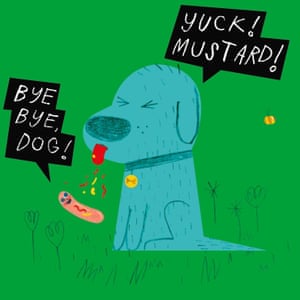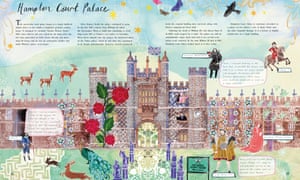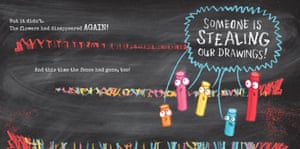Big names for small readers abound as summer creeps over the horizon, including Shirley Hughes’s new book for five- to eight-year-olds, Ruby in the Ruins (Walker), which vividly evokes a child’s view of the aftermath of war. After Ruby and Mum weather the blitz together, Dad comes home at last; but, to Ruby, he seems a huge, sunburned stranger, taking up too much space … But rather than being remote and shell-shocked, Dad is warmly sympathetic to Ruby’s escapades in this story full of resilient, hopeful love.
Visually stunning, with spare text allowing pictures to do the heavy lifting, Grahame Baker-Smith’s The Rhythm of the Rain (Templar) is a quiet, intoxicating account of water’s transmutations. Where does the water in Issac’s favourite mountain pool go? Following its progress down waterfalls, into rivers, lakes and sea, and back into the clouds, the reader is immersed in the flow of each light-filled landscape. More solid, but no less transporting, is The Buildings that Made London by David Long, with illustrations by Josie Shenoy (Bloomsbury). It delves into each building’s development and history, and the spectacular fold-out of Buckingham Palace is a triumph.

Chitra Soundar’s You’re Safe With Me (Lantana) is a perfect bedtime picture book, with mesmerising geometric illustrations by Poonam Mistry. Little jungle animals are scared by the sounds of the night; but Mama Elephant is full of reassurance for each fear. This satisfying story should become a sleep-time staple for nervier toddlers.
Riotous fun is to be found in Richard Byrne’s The Case of the Red-Bottomed Robber (Oxford), in which the little chalks, Mrs Red, their teacher, and the indefatigable Sergeant Blue track down a thief. But have they misjudged the criminal? Young readers will adore this rainbow-filled blackboard crime caper.
Sausagey silliness abounds in Hello, Hot Dog! (Frances Lincoln) by Lily Murray, full of primary-coloured peril brought to life by the brilliant Jarvis’s boldly graphic illustrations. Hot Dog is having a lovely time…until he’s rudely baptised with ketchup and mustard. Doing a backflip to escape may be beyond his skills, but can he roll to safety? This uproarious domestic dramastands out for its brightness and its few well chosen words.
For 8- to 12-year-olds, there’s a wealth of adventure, from the fast-paced to the mind-boggling. Lauren St John’s new mystery series kicks off with Kat Wolfe Investigates (Macmillan), featuring Kat, a 12-year-old pet-sitter who teams up with her new pal, Harper Lamb, to investigate the mysterious disappearance of Ramon, Kat’s parrot-owning client. Warm, intriguing characterisation, with just the right tingle of peril – not to mention a resident wildcat.
Sophie Anderson’s The House with Chicken Legs (Usborne) focuses on a young girl trapped between worlds. Marinka is learning the task of guiding the dead onwards through The Gate; but she yearns to make living friends and explore the world. This original debut takes a poignant, philosophical look at predestination and free choice, and features delectable food descriptions, cheeky jackdaws and a frolicking lamb.

The Infinite Lives of Maisie Day (Nosy Crow) is a heartbreaking, head-melting science fiction mystery from the superlative Christopher Edge. Rather than a galaxy far far away, it’s set in the home of science prodigy Maisie, on her tenth birthday – a place and time in which she seems to be trapped, in a shifting, looping reality with unnerving blackness all around her. Huge ideas – gravity, relativity, time and space – interweave seamlessly with themes of sibling jealousy and familial love; slim yet super-dense, it’s another unforgettable offering from the author of The Many Worlds of Albie Bright.
Philip Reeve offers more mind-expanding science fiction in Station Zero (Oxford), the last of the Railhead trilogy, which bridges the gap between pre-teen and teen readerships as well as it spans the voids of outer space. Former thief Zen Starling, disillusioned with his newfound wealth, stows away once more on an interstellar train; this time to seek his lost love Nova in the Black Light Zone, even though the godlike Guardians have forbidden it. What he finds might break the deadlock between the galaxy’s ruling families, and even bring back the being who first created the singing, sentient space-trains – but at what cost? Wryly witty, but also tragic and cosmically wide-ranging, Reeve’s writing brings the trilogy to a meteor-bright conclusion.
For politically minded teenagers, Tracey Mathias’s Night of the Party (Scholastic) is a furious dystopian shoulder-shake, indicting the apathy that allows both rights and ethics to be quietly discarded. Post-Brexit, an increasingly insular England elects the far right Party, who vow to deport everyone not British Born, declaring it a criminal offence to fail to report an illegal. Ash has been grieving since his sister’s mysterious drug-related death; her friend Zara, with whom he is gradually falling in love, may have answers for him. But Zara is not “BB” … Skewering both the inhuman bureaucracy of the detention centre and the casual acceptance of horrors, Mathias’s debut is a hundred-decibel alarm call.

Slower and dreamier, though not without horrors of its own, David Almond’s The Colour of the Sun (Hodder) chronicles a mystical day in a boy’s life, drawing on Almond’s own early memories. Turned out to roam with a packet of still-warm bara brith, Davie, grieving for the recent loss of his father, sees the body of a young man in a churchyard, and heads for the hills to where the murderer might be. The book explores liminal spaces: the edgelands between child and adult, being and seeming, life and death and the human and natural worlds.
Finally, Tom Pollock’s White Rabbit, Red Wolf (Walker) plunges the reader deep into Pete’s mind. A mathematical genius, he suffers from debilitating anxiety; with the help of logic and calculation, as well as his family’s support, his fears can – sometimes – be held at bay. However, the nightmares come thick and fast: his mother is stabbed, his sister disappears and Pete is left to cope alone in a situation of labyrinthine complexity. In this dark and twisted thriller, nothing is what it seems; but Pollock’s greatest triumph is the portrait of a psyche at war with itself.